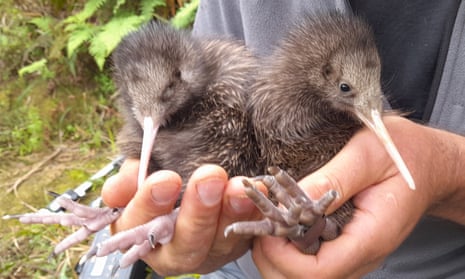Two kiwi chicks have been born in the wild around Wellington for the first time in more than 100 years, one year after the national bird was reintroduced to New Zealand’s capital.
The fluffy and flightless kiwi is one of the most vulnerable birds in New Zealand and conservationists believe it has been absent from the capital for generations.
In November 2022, 11 kiwi were released into a vast sweep of hilly farmland in Makara, 25 minutes west of Wellington’s centre. Fifty-two more birds were released between February and May this year, with another 200 to follow over the next five years.
The project had proved so successful because of the community’s enthusiastic buy-in, said Paul Ward, founder of the Capital Kiwi Project, which began six years ago.
More than 100 landowners gave permission for the project to install 4,600 stoat traps across the bird’s new 24,000ha habitat – making it the largest intensive stoat trapping network of its kind in the country.

Ward said the trapping network was just as important as the support network behind the project, which includes the Makara community, the iwi (tribe) who gifted the birds, the iwi mana whenua (tribe with territorial rights over the region) which is now kaitiaki, or guardian, of the kiwi, and the landowners.
“To have kiwi out there breeding is deeply, deeply satisfying,” Ward said, adding that it was “a very sweet milestone” that proves the area is suitable habitat.
The project chose not to name the two-week old chicks, Ward said, nor would it get into the habit of providing updates on individual kiwi because it was committed to growing a large wild population.
An estimated 12 million kiwi once roamed New Zealand, but introduced predators and habitat loss have driven those numbers to worrying lows – 68,000 at the last estimate. Conservation efforts, such as the Capital Kiwi Project, are starting, slowly, to boost kiwi numbers.
Adult kiwi are vulnerable to large predators such as dogs, but can fight off smaller pests with their large fighting claws. Kiwi chicks, however, are entirely vulnerable to predators, particularly stoats.
Just a quarter of the kiwi released into the area are being monitored, meaning there was a high possibility more chicks could be discovered, Ward said. But he cautioned that it was still early days for the chicks.
“These chicks now need to fend for themselves in the wild. The coming months are vitally important as they grow and put on weight to the point that they can fend off stoats with their big claws.”
Ward hoped the project would help educate the public about the birds’ “toughness and fighting spirit”.
“But we have to admit, they are ridiculously cute.”
